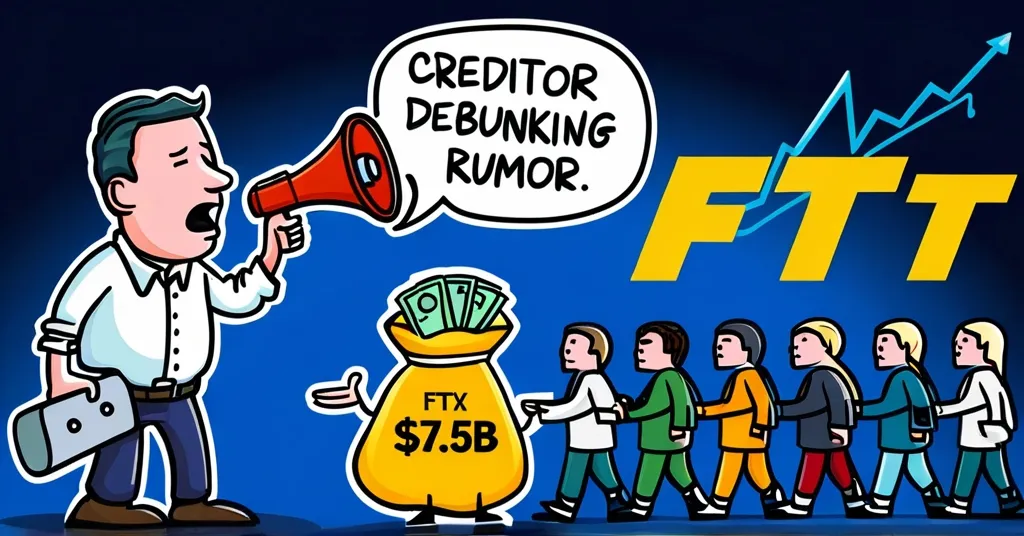FTX Creditor Clarifies: $7.5B Payout, Not $16B, Expected by March 2025

FTX Creditor Debunks $16B Payout Rumor, Clarifies $7.5B Distribution
FTX creditor Sunil has debunked rumors of a $16 billion payout starting January 3, clarifying that the first distribution will range from $6.5 billion to $7.5 billion.
- Rumor debunked: $16B payout not happening; expect $6.5B to $7.5B.
- First distribution: Within 60 days of Chapter 11 plan, by March 25, 2025.
- FTT surge: Token up 245% since September, now at $3.50.
- Ambitious plan: Aiming to repay creditors up to 119% of claims.
Correcting the Rumor
In the aftermath of FTX’s collapse, a glimmer of hope emerges amidst a sea of misinformation. Sunil, an FTX creditor, has stepped up to clear the air around a rampant rumor suggesting a hefty $16 billion cash distribution to start on January 3. Instead, he paints a more grounded picture, revealing that the first distribution will be significantly smaller, ranging from $6.5 billion to $7.5 billion.
As Sunil puts it,
False: Distribution does not start 3rd Jan and $16bn within 60 days.
This correction is a reminder of the pitfalls of speculation in a space where facts can be as volatile as the markets themselves.
FTX’s Financial Roadmap
As of now, FTX holds $13 billion in cash, with expectations to bump that figure up to $14 billion by March 2025. But it’s not all smooth sailing; the company plans to set aside a large chunk of money, about $6.5 billion, to handle legal disputes and help recover losses. This move is a nod to the many legal and financial issues that FTX must navigate as it charts its course out of bankruptcy.
Chapter 11, a legal process that allows a company to reorganize its debts and operations to avoid closing down, is at the heart of FTX’s strategy. This approach is crucial for the company’s survival and eventual recovery.
Payout Details
Smaller creditors, those owed $50,000 or less, will breathe a sigh of relief first, as they’re slated to receive their payouts within 60 days of the Chapter 11 reorganization plan going live. Sunil marks March 25, 2025, as the tentative date for the first $7 billion distribution. With BitGo and Kraken at the helm, managing these payouts, there’s a structured approach to this recovery mission.
The involvement of BitGo and Kraken, two well-known players in the crypto space, adds a layer of credibility to the payout process. However, navigating the claims process, including establishing accounts with these agents and completing KYC verification, presents its own set of challenges for customers.
The FTT Surge and Market Sentiment
Amidst these developments, the FTX Token (FTT) has been on a wild ride, soaring to $3.50 and boasting a 245% increase since September. This surge, pushing the token’s market cap over $1.1 billion, is fueled by the optimism surrounding the payouts. It’s a classic case of market sentiment swinging into action, with investors betting on the recovery plan’s success. FTT’s price is riding high, much like our hopes for a quick recovery… but let’s not get too carried away!
Technical analysis suggests a bullish trend for FTT, with a golden cross pattern formed in October. However, the potential for a double-top pattern at $4.31 hints at a possible price pullback, which could impact market sentiment around the payouts.
Ambitious Recovery Plan
The plan itself is ambitious, aiming to repay creditors up to 119% of their claims. It’s a bold move, reflecting the delicate balancing act between restitution and the realities after the company’s failure. But is it realistic? Some experts question whether this goal can be achieved, given the volatile nature of the crypto markets and the legal hurdles ahead.
FTX’s significant efforts to liquidate its crypto holdings, including substantial outflows from the Grayscale Bitcoin Trust (GBTC), have nearly doubled its cash reserves. This strategy, while necessary for creditor repayments, could also have broader market implications, potentially affecting other crypto prices and dynamics.
Broader Implications for Crypto
The FTX saga is a stark reminder of the unpredictable nature of the crypto world. From the mismanagement and fraud under Sam Bankman-Fried that led to FTX’s downfall, to the current efforts led by John J. Ray III to steer the ship back to solvency, it’s a story that encapsulates the highs and lows of decentralized finance.
It’s also a testing ground for the resilience and adaptability of the crypto ecosystem. Amidst the optimism, there’s a sobering reality check: the journey to recovery will be long, fraught with legal battles, and heavily reliant on the volatile crypto markets.
The ongoing legal proceedings against FTX’s former executives and the implications for the crypto industry’s regulatory environment highlight the broader impact of FTX’s collapse and recovery. As we navigate this saga, it’s a potent reminder of the crypto world’s potential to both dazzle and devastate, pushing the boundaries of what’s possible while testing the limits of trust and transparency.
Meanwhile, Bitcoin continues to stand as a beacon of stability and resilience in this tumultuous landscape, reminding us of the foundational principles of decentralization and financial freedom that drive the crypto revolution forward. While altcoins and other blockchains fill unique niches, Bitcoin’s role as a store of value and a hedge against traditional financial systems remains unparalleled.
Key Questions and Takeaways
- What was the rumored distribution amount from FTX, and what is the actual amount available?
The rumored amount was $16 billion, while the actual amount available for the first distribution is between $6.5 billion and $7.5 billion.
- When is the first distribution expected to occur?
The first distribution is expected within 60 days of the Chapter 11 reorganization plan going live on January 3, with the first $7 billion scheduled by March 25, 2025.
- How is FTX managing the payouts?
FTX has enlisted BitGo and Kraken to manage the payouts to creditors.
- What is the current status of the FTX Token (FTT)?
The FTX Token (FTT) has surged to $3.50, a 245% increase since September, with a market cap over $1.1 billion.
- What is the recovery plan’s goal regarding creditors’ repayment?
The recovery plan aims to repay creditors up to 119% of their claims.



